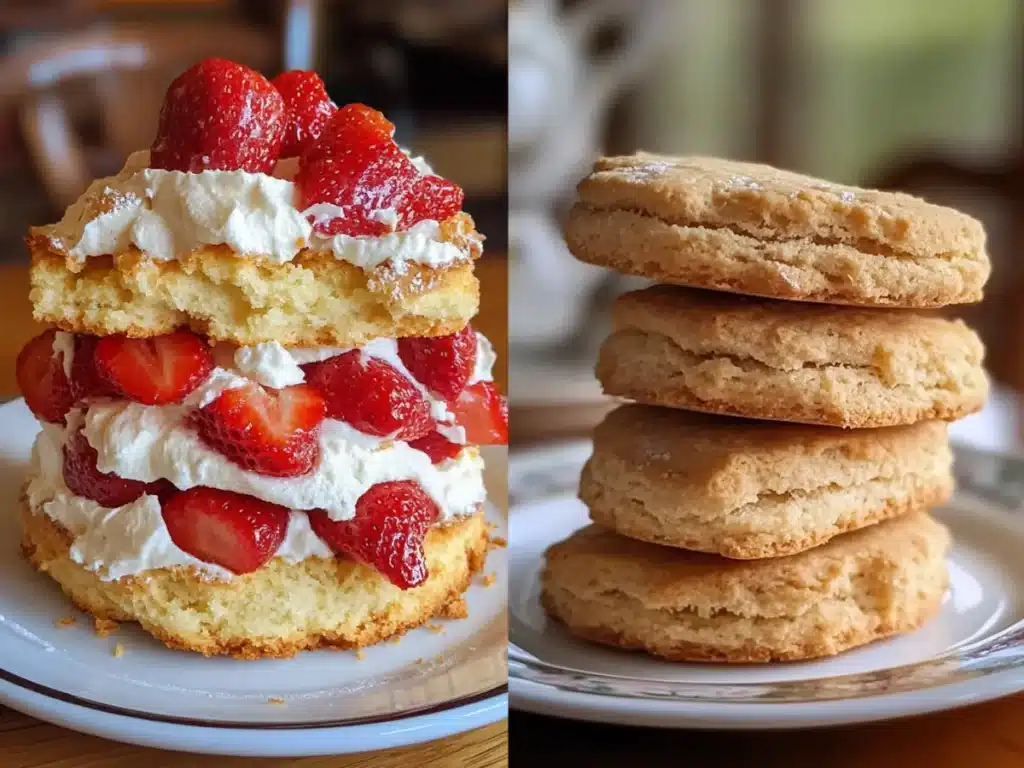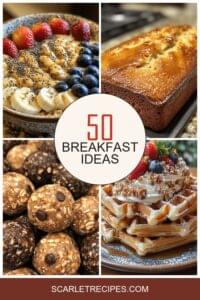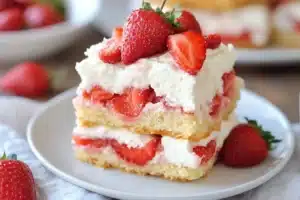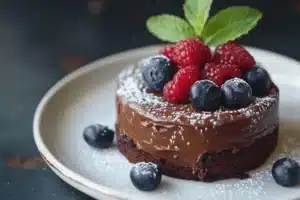What is the difference between shortcake and biscuits?
Shortcake and biscuits are two beloved baked goods that often find themselves in similar contexts but serve distinct culinary purposes. While they may look alike at a glance, their textures, flavors, and uses are quite different. If you’ve ever wondered, what is the difference between shortcake and biscuits, this article will break down the key differences, from ingredients and preparation techniques to their roles in various dishes.

Understanding the difference between shortcake and biscuits can elevate your baking and help you choose the right treat for your culinary needs. While both are delicious in their own right, knowing when to use shortcake versus biscuits can make all the difference in your desserts or savory dishes. For more insights into how biscuits compare with other baked goods, check out this article on Biscuit vs. Scone: What’s the Difference? by The Kitchn. Additionally, if you’re looking to perfect your biscuit-making skills, Serious Eats offers an in-depth guide on The Science of the Best Buttermilk Biscuits that breaks down the process scientifically.
Introduction: What Are Shortcakes and Biscuits?
Shortcake and biscuits are both types of quick breads, meaning they are leavened with baking powder or baking soda rather than yeast. Despite their similar foundations, they are typically used in different ways:
- Shortcake: Traditionally, shortcake is a sweet, crumbly cake often served with fruit and whipped cream. It is lighter and more tender, making it perfect for desserts like the classic strawberry shortcake.
- Biscuits: Biscuits, on the other hand, are a staple in American Southern cuisine. They are known for their flaky texture and are often served alongside savory dishes, although they can also be enjoyed with sweet toppings like jam or honey.
Historical Background of Shortcakes and Biscuits
Exploring the historical difference between shortcake and biscuits reveals how these baked goods have evolved over time.
Shortcakes
Shortcakes have a long history, particularly in European cuisine. The term “short” in baking refers to the use of fat, which creates a crumbly texture. In the case of shortcakes, butter or shortening is used to create a tender, delicate crumb. Historically, shortcakes were made with flour, sugar, butter, and a leavening agent, and were served with fresh fruit and cream. The most famous version, strawberry shortcake, became popular in the United States in the 19th century and remains a favorite dessert today.
Biscuits
Biscuits in the United States trace their origins back to British scones and have evolved significantly over time. Originally, biscuits were hard and dry, suitable for long-term storage and travel. However, with the introduction of chemical leavening agents like baking powder and buttermilk, biscuits became soft, flaky, and a staple of Southern cuisine. Today, they are enjoyed at breakfast with gravy, as a side with fried chicken, or simply spread with butter and jam.
Ingredient Differences Between Shortcakes and Biscuits
While both shortcakes and biscuits share some basic ingredients, the proportions and additional components differ, leading to distinct textures and flavors.
- Flour:
- Shortcakes often use a combination of all-purpose flour and cake flour to create a tender, crumbly texture that’s ideal for desserts.
- Biscuits, by contrast, typically use only all-purpose flour, which provides more structure, helping to create the flaky layers that biscuits are known for.
- Fat Content:
- Shortcakes are made with butter or shortening, cut into the flour to create a tender crumb. The fat is fully incorporated to achieve a cake-like consistency.
- Biscuits also use butter or lard, but it is left in larger chunks within the dough, which melts during baking to form the flaky layers characteristic of a good biscuit.
- Sugar:
- Shortcakes generally contain more sugar than biscuits, contributing to their sweetness and making them suitable for dessert.
- Biscuits, on the other hand, are only mildly sweet or not sweet at all, which allows them to be paired with savory dishes like gravy or fried chicken.
Preparation and Cooking Techniques
The methods used to prepare and bake shortcakes and biscuits are key to their differing textures and flavors.
Mixing Method
- Shortcakes: The dough for shortcakes is mixed gently to avoid overworking the gluten in the flour. The goal is a tender crumb, so the butter is typically cut into the flour until the mixture resembles coarse crumbs, then liquid is added to form a dough.
- Biscuits: The mixing method for biscuits is similar, but with a focus on creating flaky layers. The butter or lard is left in larger pieces, and the dough is folded or layered to create the flakiness. It’s important not to overmix biscuit dough, as this can lead to tough, dense biscuits.
Baking Process
- Shortcakes: Shortcakes are typically baked at a lower temperature than biscuits, which helps maintain their tender texture. They are baked until they are lightly golden and just set, with a soft, crumbly interior.
- Biscuits: Biscuits are baked at a higher temperature, which helps create a crisp, golden exterior while keeping the interior soft and flaky. The high heat encourages the fat in the dough to steam, which is what creates the characteristic layers in biscuits.
Texture and Appearance
- Shortcakes: The texture of a shortcake is more cake-like, with a crumbly, tender interior that pairs well with juicy fruits and whipped cream. They are typically split open and layered with these ingredients.
- Biscuits: Biscuits are known for their flaky layers, which result from the way the dough is mixed and folded. They are generally served warm, with the layers easily pulling apart, perfect for butter, jam, or savory toppings.
Culinary Uses of Shortcakes vs. Biscuits
The distinct characteristics of shortcakes and biscuits make them ideal for different culinary applications.
Shortcakes
Shortcakes are primarily used in desserts. Their slightly sweet, tender texture makes them perfect for pairing with fresh fruit and whipped cream. The most famous example is strawberry shortcake, but shortcakes can be used with any seasonal fruit, making them a versatile option for a variety of sweet treats.
Biscuits
Biscuits are incredibly versatile and are used in both sweet and savory dishes. In Southern cuisine, they are a staple at breakfast, often served with sausage gravy, or simply with butter and honey. Biscuits also make an excellent side dish for hearty meals, such as fried chicken or pot roast. They can even be used as a base for sandwiches, showcasing their versatility.
Variations and Regional Differences
Both shortcakes and biscuits have regional variations that highlight different interpretations of these classic baked goods.
Regional Takes on Shortcakes
- Southern Shortcakes: In the Southern United States, shortcakes are sometimes made with a biscuit-like dough, blurring the lines between shortcakes and biscuits. These versions are less sweet and have a denser texture.
- British Shortcakes: In the UK, shortcake often refers to a crisp, cookie-like biscuit rather than the soft, crumbly cake used in the U.S. version. This difference illustrates how regional interpretations can vary widely.
Biscuits Around the World
- American Biscuits: In the U.S., biscuits are soft and flaky, often made with buttermilk and served with savory dishes.
- British Biscuits: What Americans call cookies are referred to as biscuits in the UK. These are sweet and crisp, quite different from American biscuits.
- Scones: While not identical to biscuits, British scones are similar and are often served with clotted cream and jam. They are a bit denser and usually contain eggs and sugar, making them sweeter than traditional American biscuits.
Frequently Asked Questions (FAQs)
Here are some common questions about the differences between shortcakes and biscuits:
Can I use biscuit dough to make shortcake?
Yes, you can use biscuit dough to make a less sweet version of shortcake. Simply add more sugar to the dough and adjust the baking time as needed. The texture will be slightly different, but it can still be delicious.
What is the main difference between shortcake and a biscuit?
The main difference lies in the sweetness and texture. Shortcakes are sweeter and have a more tender, crumbly texture, while biscuits are less sweet and flakier.
Why are shortcakes sweeter than biscuits?
Shortcakes contain more sugar in the dough, which makes them sweeter and more suitable for desserts.
Can I substitute one for the other in recipes?
You can substitute one for the other with some modifications. For example, if using biscuit dough for shortcake, you may want to add more sugar and bake at a slightly lower temperature.
How do the textures of shortcakes and biscuits differ?
Shortcakes are typically more crumbly and tender, while biscuits are flaky with distinct layers.
Advanced Tips for Perfect Shortcakes and Biscuits
To perfect your shortcakes and biscuits, consider these advanced tips:
- Enhancing Flavor: Add flavor to your doughs by incorporating ingredients like lemon zest, vanilla extract, or spices such as cinnamon or nutmeg. These additions can elevate both shortcakes and biscuits.
- Perfecting Texture: For the best texture, keep your ingredients cold, particularly the fat. This helps create the flakiness in biscuits and the tender crumb in shortcakes. Additionally, using a light hand when mixing the dough will prevent overworking the gluten, ensuring the final product is tender rather than tough.
Conclusion and Final Thoughts
In conclusion, while shortcakes and biscuits share some similarities, they are distinct in both preparation and purpose. Shortcakes are typically sweeter and used in desserts, offering a tender, crumbly texture that pairs well with fruit and cream. Biscuits, on the other hand, are flakier and less sweet, making them perfect for savory applications. By understanding these differences, you can better appreciate the unique qualities of each and use them to their fullest potential in your cooking and baking.
Whether you prefer the sweet indulgence of a shortcake or the buttery layers of a biscuit, both have their place in the kitchen. Experiment with different recipes and techniques to find your favorite version of these classic baked goods.


